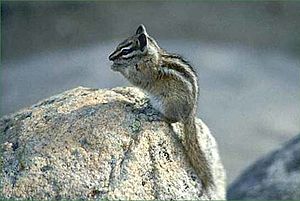Palmer's chipmunk facts for kids
Quick facts for kids Palmer's chipmunk |
|
|---|---|
 |
|
| Conservation status | |
| Scientific classification | |
| Genus: |
Neotamias
|
| Species: |
palmeri
|
| Synonyms | |
|
Tamias palmeri |
|
Palmer's chipmunk (Neotamias palmeri) is a species of rodent in the family Sciuridae, endemic to Nevada. Its natural habitat is temperate forests. It is threatened by habitat loss.
Description
Palmer's chipmunk resembles other chipmunks in that it has solid black and white stripes that run down its body dorsally. The body of the chipmunk is tan while its ventral side is more pale. Total body length is 210–223 millimetres (8.3–8.8 in), with a tail of 86.5–101.5 millimetres (3.41–4.00 in). Adults weigh between 50 and 69.4 grams.
Distribution and habitat
Palmer's chipmunk is found only in the Spring Mountains of Clark County, southern Nevada. It mostly occurs at altitudes of 7,000–10,000 feet (2,100–3,000 m), inhabiting cliffs and forested areas between the upper pinyon pine and juniper regions, up and into the fir-pine and bristlecone pine communities. There are some indications that the species prefers to associate with water sources.
Ecology
The caches of Palmer's chipmunk have been found to contain seeds from the ponderosa pine, which are an important food resource of the chipmunk. This species has also been known to eat local fruits, grass, insects, and the seeds of other conifers. The species hibernates during cold weather, but is not an obligate hibernator. On warm winter days, Palmer's chipmunk will come out of its burrow to visit their caches for food.
Reproduction
Nests are most commonly built on the ground but can occasionally be found in trees. In late spring to early summer, female chipmunks have litters of 3 or 4 pups which are born hairless. After a month or so, the pups have developed a smooth fur coat and begin to move in and out of the nest. At about 6 weeks old, the pups have moved to a mostly solid food diet.
Conservation
The species has been classified as Endangered by the IUCN. Its habitat is being reduced by the extension of campgrounds, woodcutting, and the increasing sprawl of Las Vegas. Predation by feral dogs and cats is also likely to be a factor.
See also
 In Spanish: Neotamias palmeri para niños
In Spanish: Neotamias palmeri para niños


